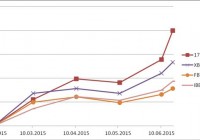Duke Energy Should Be On An Income Investor’s List
The company is streamlining its operations and focus on growth should propel its stock price. Increased revenues and cash flows from growth projects should result in increased dividend growth. Current price represents a good entry point for long term investors. Duke Energy (NYSE: DUK ) has had mixed fortunes over the past five quarters. The revenues and earnings of the company have been fluctuating, which is odd for a large utility like Duke. The trend in the stock price has been consistent with the trend in its revenues and earnings over the last twelve months. It touched $90 in January but could not maintain that level and the stock has been on a declining trend over the last six months. This, I believe, has created a good entry point for income investors. Duke Energy has been repositioning its business by selling its competitive business assets. The company has strategic growth plans that involve getting an extended, renewable energy generation asset base; such plans will benefit the company in the long-run, as the company’s revenue and cash flow growth will improve which will reduce shareholder risk and maintain investors’ confidence in the longer term. The company is seeking an opportunity to invest in Green projects worth $4 billion which will further boost its growth. It has also plans for the accelerated investments in solar, biomass and natural gas. Duke also plans to convert its coal field plants to natural gas ones in order to have larger asset base. However, this is a long-term investment, approximately 4 to 5 years horizon should be kept in mind. It will be a joint venture to service more territories with expanded gas generation. As a result, this huge investment will boost growth that in return will increase revenues and maintain stable cash flow base. This will have a significant positive affect on the DUK’s share price. On the other hand, the recent sale of non-regulated Midwest assets and the subsequent buy back of shares will increase the company’s earnings per share. It will also allow DUK to repay debt and make its financial position stronger. Duke Energy also has plans to access some cash, in the form of unremitted international business earnings, in the next 8 years that will have a positive effect on its performance. This will allow the company to grow its profitable operations and expand its natural gas pipelines in North Carolina, as discussed above, to cater for more demand. Furthermore, the cash from international business segments will finance future growth and create value for its shareholders in the longer term. Duke energy is a good investment for income investors – it yields a return of 4.1%, with dividends paid quarterly. All of the above repositioning strategies will accelerate dividend growth for the shareholders. It will also improve the overall business risk of DUK and make investors more confident as it will also lower the shareholders’ risk. However, the company will remain exposed to the risk of sudden changes in regulatory restrictions. In addition, any carelessness exhibited by company’s management during the execution of its planned investment might hinder its future growth potentials. Furthermore, unforeseen negative economic changes, foreign currency volatility and adverse weather conditions are key risks that might restrict its stock price performance in the years ahead. Duke’s long term prospects look good. However, with the demand growth in the US expected to slow in the coming years, Duke Energy might face some difficulties on the revenues front in the domestic market. As a backup plan, it can still generate growth with its international energy business by focusing on overseas operations. Duke has effectively modified its portfolio with wind and solar power projects lined up for the future. Most importantly, this company also remains committed towards enhancing operational efficiency and cutting down costs to further fuel earnings growth. In conclusion, Duke Energy had a successful 2014, is off to another strong one this year, and if all goes according to the plan, it will pass along another dividend increase to shareholders very soon. The company’s share price is currently following a declining trend, but with revenues and earnings expected to rise due to the growth projects, there is a lot of upside to the share price. For income investors looking for a stable, secure, high-yield investment opportunity, Duke Energy should certainly be considered. Disclosure: I am not a registered investment advisor and the views expressed in this article are my own. These views should not be taken as an investment advice or recommendation to buy or sell the shares. Investors should conduct their own due diligence before making an investment decision. Disclosure: I/we have no positions in any stocks mentioned, and no plans to initiate any positions within the next 72 hours. (More…) I wrote this article myself, and it expresses my own opinions. I am not receiving compensation for it (other than from Seeking Alpha). I have no business relationship with any company whose stock is mentioned in this article.
